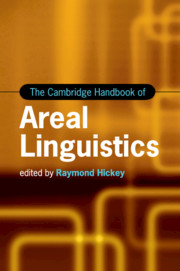Book contents
- The Cambridge Handbook of Areal Linguistics
- Cambridge Handbooks in Language and Linguistics
- The Cambridge Handbook of Areal Linguistics
- Copyright page
- Contents
- Figures
- Maps
- Tables
- Contributors
- Preface
- 1 Areas, Areal Features and Areality
- Part I Issues in Areal Linguistics
- Part II Case Studies for Areal Linguistics
- 9 The Germanic Languages and Areal Linguistics
- 10 Britain and Ireland1
- 11 Varieties of English
- 12 Slavic Languages
- 13 The Caucasus
- 14 Western Asia: East Anatolia as a Transition Zone
- 15 An Areal View of Africa
- 16 Areal Contact in Nilo-Saharan
- 17 Niger-Congo Languages
- 18 The Kalahari Basin Area as a ‘Sprachbund’ before the Bantu Expansion
- 19 South Africa and Areal Linguistics
- 20 Jharkhand as a ‘Linguistic Area’: Language Contact Between Indo-Aryan and Munda in Eastern-Central South Asia
- 21 Sri Lanka and South India
- 22 The Transeurasian Languages
- 23 The Changing Profile of Case Marking in the Northeastern Siberia Area
- 24 Languages of China in their East and Southeast Asian Context
- 25 Language in the Mainland Southeast Asia Area
- 26 Southeast Asian Tone in Areal Perspective
- 27 The Areal Linguistics of Australia
- 28 Languages of the New Guinea Region
- 29 Languages of Eastern Melanesia
- 30 The Western Micronesian Sprachbund
- 31 Native North American Languages
- 32 The Areal Linguistics of Amazonia
- 33 Linguistic Areas, Linguistic Convergence and River Systems in South America
- Index
- References
12 - Slavic Languages
from Part II - Case Studies for Areal Linguistics
Published online by Cambridge University Press: 11 May 2017
- The Cambridge Handbook of Areal Linguistics
- Cambridge Handbooks in Language and Linguistics
- The Cambridge Handbook of Areal Linguistics
- Copyright page
- Contents
- Figures
- Maps
- Tables
- Contributors
- Preface
- 1 Areas, Areal Features and Areality
- Part I Issues in Areal Linguistics
- Part II Case Studies for Areal Linguistics
- 9 The Germanic Languages and Areal Linguistics
- 10 Britain and Ireland1
- 11 Varieties of English
- 12 Slavic Languages
- 13 The Caucasus
- 14 Western Asia: East Anatolia as a Transition Zone
- 15 An Areal View of Africa
- 16 Areal Contact in Nilo-Saharan
- 17 Niger-Congo Languages
- 18 The Kalahari Basin Area as a ‘Sprachbund’ before the Bantu Expansion
- 19 South Africa and Areal Linguistics
- 20 Jharkhand as a ‘Linguistic Area’: Language Contact Between Indo-Aryan and Munda in Eastern-Central South Asia
- 21 Sri Lanka and South India
- 22 The Transeurasian Languages
- 23 The Changing Profile of Case Marking in the Northeastern Siberia Area
- 24 Languages of China in their East and Southeast Asian Context
- 25 Language in the Mainland Southeast Asia Area
- 26 Southeast Asian Tone in Areal Perspective
- 27 The Areal Linguistics of Australia
- 28 Languages of the New Guinea Region
- 29 Languages of Eastern Melanesia
- 30 The Western Micronesian Sprachbund
- 31 Native North American Languages
- 32 The Areal Linguistics of Amazonia
- 33 Linguistic Areas, Linguistic Convergence and River Systems in South America
- Index
- References
- Type
- Chapter
- Information
- The Cambridge Handbook of Areal Linguistics , pp. 331 - 355Publisher: Cambridge University PressPrint publication year: 2017

